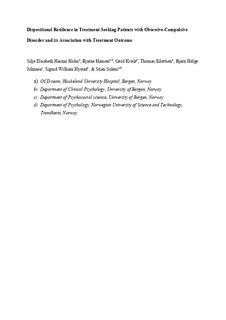| dc.contributor.author | Holm, Silje Elisabeth Hasmo | |
| dc.contributor.author | Hansen, Bjarne | |
| dc.contributor.author | Kvale, Gerd | |
| dc.contributor.author | Eilertsen, Thomas | |
| dc.contributor.author | Johnsen, Bjørn Helge | |
| dc.contributor.author | Hystad, Sigurd William | |
| dc.contributor.author | Solem, Stian | |
| dc.date.accessioned | 2019-11-14T07:14:24Z | |
| dc.date.available | 2019-11-14T07:14:24Z | |
| dc.date.created | 2019-07-08T11:33:29Z | |
| dc.date.issued | 2019 | |
| dc.identifier.citation | Scandinavian Journal of Psychology. 2019, 60 (3), 243-251. | nb_NO |
| dc.identifier.issn | 0036-5564 | |
| dc.identifier.uri | http://hdl.handle.net/11250/2628393 | |
| dc.description.abstract | There is a lack of research on the relation between obsessive‐compulsive disorder (OCD) and resilience. Dispositional resilience, as described and defined in literature on hardiness, consists of three facets, namely beliefs about having control in everyday living, having a sense of purpose or commitment, and a positive attitude toward challenges. This study explores associations between dispositional resilience (measured with the Dispositional Resilience Scale (DRS‐15‐R)), symptom severity, and treatment outcome in a sample of 89 patients treated with concentrated exposure therapy (cET), and compares the findings with scores from two reference groups (students and soldiers). The patient group had significantly lower resilience scores than the two reference groups. Weak correlations were observed between dispositional resilience and OCD symptoms. Differences in dispositional resilience were weakly related to remission status at follow‐up (odds ratio of 1.11). Furthermore, resilience improved from pre‐ to post‐treatment (Cohen's d of 0.65). Our results imply that patients’ initial resilience score does not hinder nor facilitate treatment effects to a great extent in this format of ERP treatment. | nb_NO |
| dc.language.iso | eng | nb_NO |
| dc.publisher | Wiley | nb_NO |
| dc.title | Dispositional resilience in treatment‐seeking patients with obsessive‐compulsive disorder and its association with treatment outcome | nb_NO |
| dc.type | Journal article | nb_NO |
| dc.type | Peer reviewed | nb_NO |
| dc.description.version | acceptedVersion | nb_NO |
| dc.source.pagenumber | 243-251 | nb_NO |
| dc.source.volume | 60 | nb_NO |
| dc.source.journal | Scandinavian Journal of Psychology | nb_NO |
| dc.source.issue | 3 | nb_NO |
| dc.identifier.doi | 10.1111/sjop.12531 | |
| dc.identifier.cristin | 1710609 | |
| dc.description.localcode | Locked until 6.3.2020 due to copyright restrictions. This is the peer reviewed version of an article, which has been published in final form at [https://doi.org/10.1111/sjop.12531]. This article may be used for non-commercial purposes in accordance with Wiley Terms and Conditions for Self-Archiving. | nb_NO |
| cristin.unitcode | 194,67,40,0 | |
| cristin.unitname | Institutt for psykologi | |
| cristin.ispublished | true | |
| cristin.fulltext | original | |
| cristin.qualitycode | 1 | |
